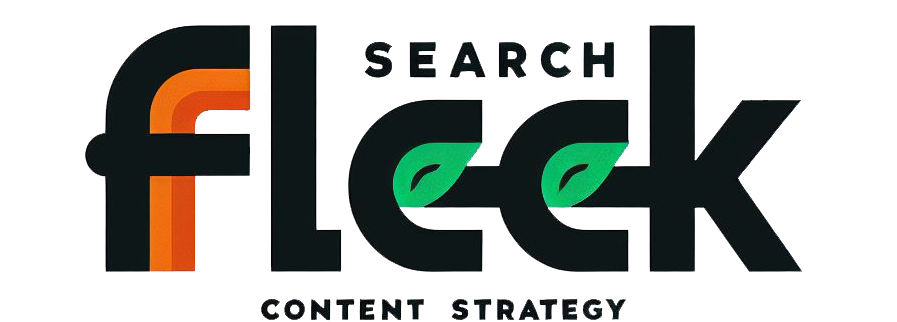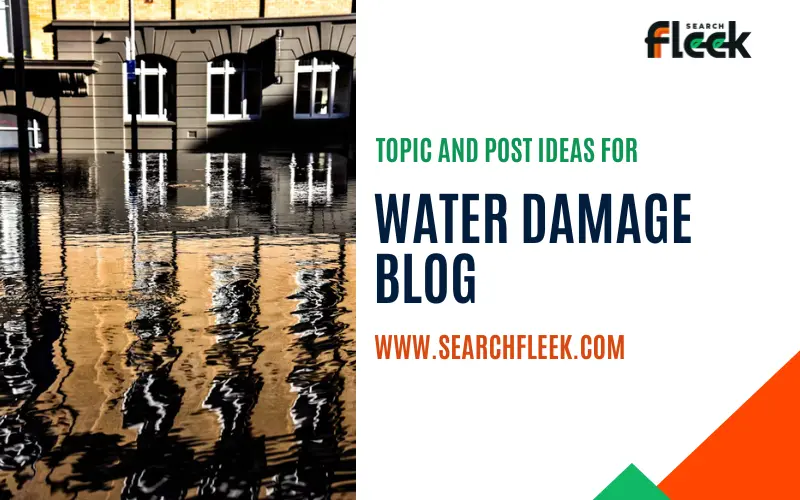Water damage can turn a relaxing evening at home into a stressful nightmare. Whether it’s a burst pipe or a leaky appliance, water damage can cause significant harm to your property and belongings. However, knowledge is power. By being informed and prepared, you can minimize damage and ensure a smoother restoration process.
This blog post, brought to you by Search Fleek, equips you with 21 captivating blog topic ideas to empower you in dealing with water damage:
21 Water Damage Blog Blog Ideas
Understanding Water Damage
- Common Causes of Water Damage in Your Home: Identify the most frequent culprits of water damage, including burst pipes, appliance malfunctions, roof leaks, and foundation issues.
- The Silent Threat: Hidden Water Damage and How to Detect It: Explore ways to identify potential hidden water damage before it causes major problems.
- The Impact of Water Damage: From Property to Possessions: Discuss the various ways water damage can affect your home, including structural damage, ruined belongings, and mold growth.
- Water Damage Severity Levels: Knowing When to Act: Explain different water damage severity levels and guide readers on when immediate action is necessary.
- The Importance of Acting Quickly After Water Damage: Emphasize the importance of prompt response to water damage to minimize further harm and facilitate a faster restoration process.
- Water Damage and Your Insurance Coverage: Educate readers about typical water damage coverage in homeowners’ insurance and the importance of understanding policy details.
- Preparing an Emergency Plan for Water Damage: Encourage readers to create an emergency plan outlining response steps and contact information for key services in case of water damage.
Taking Action After Water Damage
- Immediate Steps to Take After Water Damage: Provide a clear and concise action plan for the first crucial hours after a water damage incident, like shutting off the water source and preventing further spread.
- Documenting Water Damage: Highlight the importance of thorough documentation, including photos, videos, and damage lists, for insurance claims and potential legal disputes.
- Salvaging Water-Damaged Belongings: Offer practical tips for salvaging water-damaged furniture, carpets, and personal belongings based on the severity of the damage.
- When to Call a Water Damage Restoration Professional: Guide readers on determining when professional restoration services are essential for a successful and safe cleanup.
- Choosing a Reputable Water Damage Restoration Company: Equip readers with criteria for selecting a qualified and trustworthy water damage restoration company.
- Working with Your Insurance Company After Water Damage: Offer tips for effective communication with your insurance provider throughout the water damage claim process.
- Water Damage Restoration Timeline: What to Expect: Provide a general overview of the water damage restoration timeline, detailing stages like assessment, drying, repairs, and reconstruction.
Living with Water Damage
- Preventing Mold Growth After Water Damage: Discuss the importance of preventing mold growth to protect your health and property.
- Air Quality Concerns After Water Damage: Educate readers about potential air quality issues following water damage and strategies for improving indoor air quality.
- The Emotional Impact of Water Damage: Acknowledge the emotional stress and anxiety associated with water damage and offer tips for coping mechanisms.
- Water Damage and Your Health: Discuss potential health risks associated with water damage, such as respiratory problems and allergies, particularly due to mold exposure.
- Preventing Water Damage Recurrence: Explore strategies for preventing future water damage incidents, including proactive maintenance of plumbing systems and regular roof inspections.
- Building a Water Damage Emergency Kit: Recommend essential items to include in a water damage emergency kit for a quicker and more efficient response.
- Water Damage Resources: Where to Find Help: Provide a comprehensive list of online resources, government agencies, and professional organizations that offer water damage information and support.
By understanding the causes and consequences of water damage, knowing how to respond effectively, and taking steps to prevent future incidents, you can minimize the stress and disruption associated with this unfortunate event. Remember, knowledge and preparedness are key tools in navigating water damage and protecting your home.
Taking Action After Water Damage: Mitigating Losses and Starting Recovery
The initial hours after a water damage incident are crucial. Taking swift and decisive action can minimize further damage and pave the way for a more efficient restoration process. Here’s a breakdown of key steps to take after water damage strikes:
Stop the Source:
The first priority is to identify and shut off the water source to prevent further water flow and worsening damage. This might involve turning off the main water valve in your home, or for specific appliance malfunctions, turning off the appropriate isolation valve.
Contain the Spread:
Once the source is stopped, take steps to limit the spread of water. Move furniture and belongings away from wet areas, and use towels or dams to channel water away from unaffected areas.
Assess the Damage:
Safely assess the extent of the damage. Document everything with photos and videos, including the water source, damaged areas, and the overall scene.
Salvage Belongings:
For salvageable belongings, begin the drying process immediately. Remove excess water with towels, elevate furniture to promote air circulation, and open windows for ventilation if weather permits.
Contact Your Insurance Company:
Promptly contact your insurance provider to file a water damage claim. Be prepared to provide details about the incident and the documented damage.
By taking these initial steps, you’ll be well on your way to mitigating the impact of water damage and initiating the restoration process. Remember, the faster you act, the better the chances of minimizing losses and restoring your home to its pre-damage condition.
Living with Water Damage: Coping with the Aftermath and Protecting Your Health
Water damage can be a physically and emotionally stressful experience. Beyond the immediate disruption and damage to your property, there are potential health concerns and long-term restoration processes to navigate. Here’s how to manage the aftermath and prioritize your well-being:
- Prioritizing Safety: After a water damage event, ensure the safety of yourself and your family. Avoid electrical hazards and wear appropriate protective gear like gloves and boots when cleaning up.
- Mitigating Mold Growth: Mold thrives in damp environments. Prompt action is crucial to prevent mold growth, which can pose serious health risks. Ensure proper ventilation and dehumidification to dry out affected areas. If significant mold growth is present, consider contacting a professional remediation company.
- Protecting Your Health: Be aware of potential health risks associated with water damage, particularly respiratory problems and allergies due to mold exposure. If you experience any health concerns, consult a medical professional.
- Managing Emotional Stress: Water damage can be a stressful experience. Don’t hesitate to seek emotional support from friends, family, or a therapist.
- Living Arrangements During Restoration: Depending on the severity of the damage, temporary living arrangements might be necessary during the restoration process. Explore options like staying with family or friends, or consider utilizing alternative housing covered by your insurance policy.
- Working with Professionals: The restoration process often involves collaborating with various professionals. This could include a water damage restoration company, a plumber for repairs, or a contractor for reconstruction work. Communicate clearly and maintain detailed records of all communication and agreements.
Remember, dealing with water damage can feel overwhelming. By prioritizing safety, addressing health concerns, and seeking support from professionals, you can navigate this challenging time and get your home back to its former comfort and safety.
Hitting the Content Bullseye: Why Topic Research Matters
Imagine spending hours crafting a blog post, only for crickets to greet you in the comments. Yikes! Strategic topic research is your secret weapon. Here’s how it benefits your business blog:
- Target the Right Audience: Research helps you identify the topics and keywords your ideal customers are actively searching for online. This ensures your content speaks directly to their needs and interests, attracting the right kind of website traffic.
- Content that Converts: When your blog addresses genuine customer concerns and questions, it builds trust and positions you as an authority. This translates to higher engagement, potential leads, and ultimately, conversions.
- SEO Powerhouse: Content rich with relevant keywords signals to search engines that your blog is a valuable resource, improving your ranking and attracting organic traffic.
- Content Graveyard Avoided: Topic research steers you away from irrelevant themes, ensuring your content attracts the right audience and drives results for your business.
FAQ: Water Damage Woes Answered
A: Shut off the water source if possible, and contact a qualified plumber to locate and repair the leak. Address any damaged areas promptly to prevent further water damage and mold growth.
A: Regularly maintain your plumbing system, schedule routine inspections for your roof and appliances, and invest in water leak detectors for vulnerable areas.
A: Review your policy details and understand the covered water damage scenarios. If you believe the denial is unfair, contact your insurance company and request a review of your claim.
A: The restoration timeline varies depending on the extent of the damage. It can range from a few days for minor leaks to several weeks for large-scale water damage events.
Conclusion
Water damage can be a disruptive and stressful experience. However, by being informed and prepared, you can minimize the damage and navigate the restoration process effectively.
Search Fleek hopes this blog post has empowered you with valuable information and resources to tackle water damage challenges. Remember, with knowledge and proactive measures, you can protect your home and ensure a smooth recovery process.
Don’t let your blog post become another victim of the “TL;DR” (too long; didn’t read) crowd. A strategic content outline becomes your time-saving hero. It helps you stay focused, prioritize key information, and integrate relevant keywords efficiently, ultimately creating a concise and engaging blog post that grabs readers’ attention and drives SEO success. Captivate your audience with a well-outlined post – they’ll thank you for it!
Emon Anam, CEO of Search Fleek, isn't your typical digital guru. He brings a unique blend of financial expertise (former banking pro!) and digital marketing mastery to the table. A self-proclaimed "SEO Sherlock Holmes," Emon unlocks content secrets for local businesses and SaaS companies. But beyond the keyboard, he's a devoted family man, music enthusiast, and cricket champion. Let Emon weave your digital success story!




